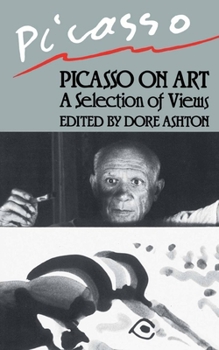Picasso on Art
Select Format
Select Condition 
Book Overview
An anthology of Pablo Picasso's statements about art
"Every page explodes with curt, outrageous aphorisms that confounded one's comfortable idees recues. Lipchitz maintains that Picasso refused to talk seriously about art--'Don't talk to the driver' was his favorite phrase when conversation got heavy; but nothing could be more penetrating than his jokes, more devastating that his pronunciamentos."--Rackstraw Downes, New York Times Book Review
"Picasso is amazingly lucid and literate in what he says about himself and his colleagues, more so, in fact, than his explicators."--Douglas Davis, Newsweek
"It is very good news that Dore Ashton's excellent anthology of Picasso's statements on art is once again in print. Together, the texts she has very judiciously selected and effectively translated give us a vivid picture both of the artist and of his wonderfully original, provocative thinking about art. Every student of 20-century art should read this book, and I for one intend to make sure that all of my students read it."--Theodore Reff, Professor of Art History, Columbia University
"Every page explodes with curt, outrageous aphorisms that confounded one's comfortable idees recues. Lipchitz maintains that Picasso refused to talk seriously about art--'Don't talk to the driver' was his favorite phrase when conversation got heavy; but nothing could be more penetrating than his jokes, more devastating that his pronunciamentos."--Rackstraw Downes, New York Times Book Review
"Picasso is amazingly lucid and literate in what he says about himself and his colleagues, more so, in fact, than his explicators."--Douglas Davis, Newsweek
"It is very good news that Dore Ashton's excellent anthology of Picasso's statements on art is once again in print. Together, the texts she has very judiciously selected and effectively translated give us a vivid picture both of the artist and of his wonderfully original, provocative thinking about art. Every student of 20-century art should read this book, and I for one intend to make sure that all of my students read it."--Theodore Reff, Professor of Art History, Columbia University
Format:Paperback
Language:English
ISBN:0306803305
ISBN13:9780306803307
Release Date:August 1988
Publisher:Grand Central Publishing
Length:224 Pages
Weight:0.70 lbs.
Dimensions:0.5" x 5.0" x 8.1"
Customer Reviews
3 ratings
Absolutely Entertaining
Published by Thriftbooks.com User , 18 years ago
Picasso is quite a personality and that comes through in this book. I would recommend reading this book along with Gertrude Stein's book on him.
Understanding art
Published by Thriftbooks.com User , 18 years ago
"Everyone wants to understand art," reflects Picasso early in this book. "Why not try to understand the songs of a bird?" It is a playful observation, and one that can only emanate, we imagine, from the mind of an artist throughly engaged with the material on palette. Picasso's witty comparison suggests art's elusive form and implies a truism which the reader will discover to be a driving force throughout these pages: The audience to a work of art, like its creator, succeeds by embracing rather than understanding the rendered object. It is the artist's full embrace which resolves itself into an all-encompassing vision, the very contradictions inherent in that panoramic view requiring for their complete rendition an array of angled planes that can only be created by the shattering of constructive materials. Hence arises that formal abstraction that so often mystifies those who seek understanding through simple assertion. How many individuals, indeed, feel that certain works by Picasso misrepresent rather than render the real? "We all know that Art is not truth," muses Picasso in acknowledgment of this confusion. "Art is a lie that makes us realize truth, at least the truth that is given us to understand." The truth that is so realized, adds Picasso, is something different from the artist's original vision, for the truly rendered subject, in a paradox, evaporates. Picasso recalls an effort to paint the portraits of two people; by the time his work was done his subjects existed no longer. In the artist's words: "The `vision' of them gave me a preliminary emotion; then little by little their actual presences became blurred; they developed into a fiction and then disappeared altogether, or rather they were transformed into all kinds of problems. They are no longer two people, you see, but forms and colors: forms and colors that have taken on, meanwhile, the idea of two people and preserve the vibrations of their life." So Picasso's human beings become real by disappearing from view, just as Isabel Archer becomes fully realized by vanishing at the conclusion of Henry James's novel. Art reveals truth by lying. Subjects become realized by disappearing. Any reader witness to this book's magical paradoxes, arising as they do from that hidden place where the creative flint strikes steel, can only view Picasso's observations as lending to our vision of artistic discourse a rich chiaroscuro. We cannot say this book will deepen the reader's understanding of art, unless by that understanding one means an embrace of the imaginative machine's secret pistons.
Engaging
Published by Thriftbooks.com User , 23 years ago
An engaging, if not wholly cohesive, account of Picasso's sayoing and writings about art, but more. The strength of the book comes when he speaks on art. The ancilliary issues that come up serve to round out the figure of Picasso more, but may not quite be the art treatise you're looking for.






